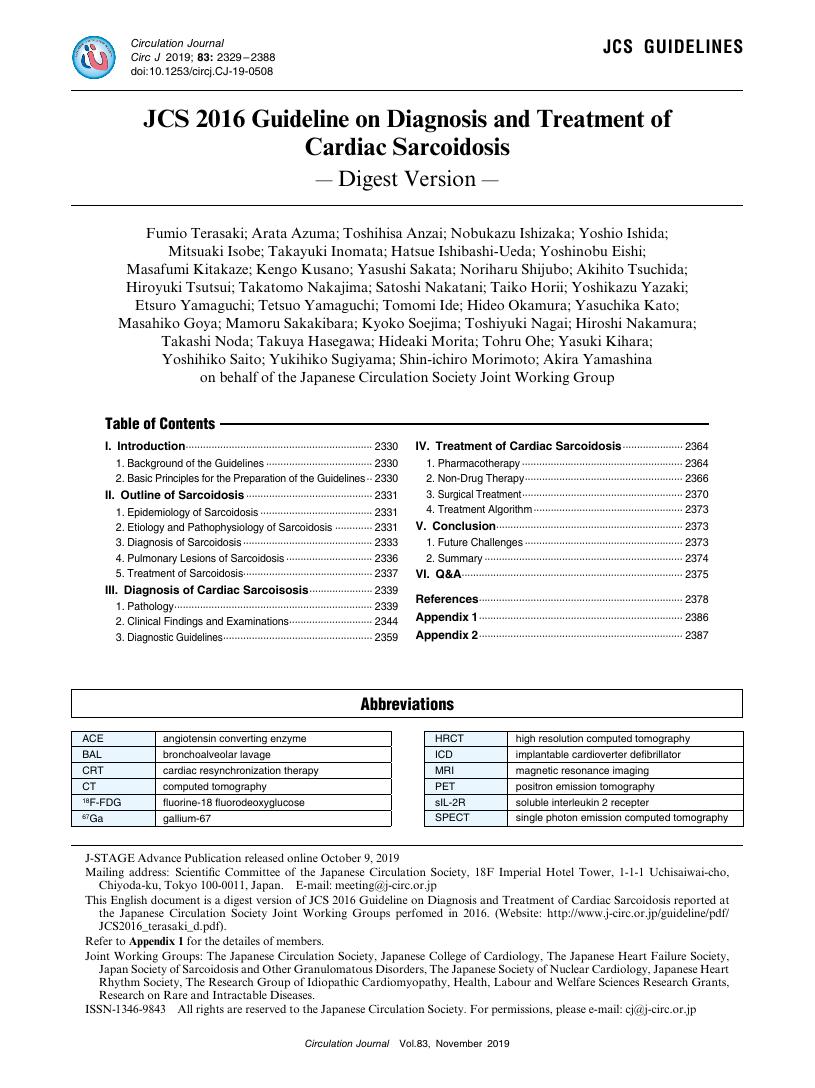- 著者
- Fumio Terasaki Arata Azuma Toshihisa Anzai Nobukazu Ishizaka Yoshio Ishida Mitsuaki Isobe Takayuki Inomata Hatsue Ishibashi-Ueda Yoshinobu Eishi Masafumi Kitakaze Kengo Kusano Yasushi Sakata Noriharu Shijubo Akihito Tsuchida Hiroyuki Tsutsui Takatomo Nakajima Satoshi Nakatani Taiko Horii Yoshikazu Yazaki Etsuro Yamaguchi Tetsuo Yamaguchi Tomomi Ide Hideo Okamura Yasuchika Kato Masahiko Goya Mamoru Sakakibara Kyoko Soejima Toshiyuki Nagai Hiroshi Nakamura Takashi Noda Takuya Hasegawa Hideaki Morita Tohru Ohe Yasuki Kihara Yoshihiko Saito Yukihiko Sugiyama Shin-ichiro Morimoto Akira Yamashina on behalf of the Japanese Circulation Society Joint Working Group
- 出版者
- The Japanese Circulation Society
- 雑誌
- Circulation Journal (ISSN:13469843)
- 巻号頁・発行日
- vol.83, no.11, pp.2329-2388, 2019-10-25 (Released:2019-10-25)
- 参考文献数
- 355
- 被引用文献数
- 95 243
- 著者
- Ryo HARAGUCHI Naozo SUGIMOTO Shigeru EIHO Yoshio ISHIDA
- 出版者
- The Institute of Electronics, Information and Communication Engineers
- 雑誌
- IEICE TRANSACTIONS on Information and Systems (ISSN:09168532)
- 巻号頁・発行日
- vol.E85-D, no.1, pp.69-76, 2002-01-01
This paper deals with a method of registration and superimposition of a coronary arterial tree on a myocardial SPECT (Single Photon Emission Computed Tomography) image. We can grasp the myocardial function more easily in connection with the shape of the coronary arterial tree. The superimposed image is easily obtainable through some manual pointing on coronary angiograms (CAG) followed by an automatic matching method: First, a rough shape model of left ventricle is estimated by using SPECT data. This 3-D left ventricular model is projected on a pair of bi-plane CAG images. We can obtain two 2-D coronary images on bull's eye map by scanning the left ventricular surface projected on CAG. By maximizing a matching degree between two 2-D coronary images, registration between CAG and SPECT is performed. Finally the superimposed image is obtained by integrating two 2-D coronary images and bull's eye image of SPECT. We validated our method by numerical experiments with artificial data set and also applied it to two clinical data sets.
1 0 0 0 IR 第8次南極地域観測越冬隊宇宙線部門報告 : 宇宙線中性子連続観測
- 著者
- 石田 喜雄 小玉 正弘 Yoshio ISHIDA Masahiro KODAMA
- 雑誌
- 南極資料 (ISSN:00857289)
- 巻号頁・発行日
- vol.35, pp.1-21, 1969-07
At Syowa Station, Antarctica, the cosmic-ray neutron observation was made, at the initial stage, with the IGY-type neutron monitor during the period from March 1960 to December 1961. On the opportunity of IQSY, a new type of cosmic-ray meter, IQSY-type neutron monitor, was developed by CARMICHAEL. In February 1967, the IQSY-type neutron monitor consisting of three counters (3-NM-64) was installed at Syowa Station in the 8th Japanese Antarctic Research Expedition. In February 1968 seven counters were added and two more in February 1969, finally twelve counters. The recording system for observation comprises the so-called multiplicity meter, by which the counting rates are divided into six channels, multiplicity=1 to more than 6, according to the neutron multiplicity detected within the gating time of 1 m sec. The counting rates are automatically printed and punched on a tape every ten minutes. This readout equipment became duplex since February 1968. The cosmic-ray observation room was specially designed so as to avoid influence of snowdrift around the building in which the neutron monitor is installed, and also to keep the room temperature constant throughout the year. In practice, no snow effect on the neutron intensity was recognized and the room temperature was 20°±1℃ in 1967. This report describes details of the cosmic-ray neutron observation in 1967-1968 and some results deduced from data analyses The atmospheric effect, the diurnal variation and the Forbush decrease were investigated in connection with the neutron multiplicity, particularly with regard to the remarkable Forbush event in May 1967.
- 著者
- Tetsuo Minamino Shuichiro Higo Ryo Araki Shungo Hikoso Daisaku Nakatani Hiroshi Suzuki Takahisa Yamada Masaaki Okutsu Kouji Yamamoto Yasushi Fujio Yoshio Ishida Takuya Ozawa Kiminori Kato Ken Toba Yoshifusa Aizawa Issei Komuro EPO-AMI-II Investigators
- 出版者
- The Japanese Circulation Society
- 雑誌
- Circulation Journal (ISSN:13469843)
- 巻号頁・発行日
- pp.CJ-17-0889, (Released:2018-02-02)
- 参考文献数
- 21
- 被引用文献数
- 15
Background:Erythropoietin (EPO) has antiapoptotic and tissue-protective effects, but previous clinical studies using high-dose EPO have not shown cardioprotective effects, probably because of platelet activation and a lack of knowledge regarding the optimal dose. In contrast, a small pilot study using low-dose EPO has shown improvement in left ventricular function without adverse cardiovascular events.Methods and Results:We performed a multicenter (25 hospitals), prospective, randomized, double-blind, placebo-controlled, dose-finding study to clarify the efficacy and safety of low-dose EPO in patients with ST-segment elevation myocardial infarction (STEMI) under the Evaluation System of Investigational Medical Care of the Ministry of Health, Labor and Welfare of Japan. In total, 198 STEMI patients with low left ventricular ejection fraction (LVEF <50%) were randomly assigned to receive intravenous administration of EPO (6,000 or 12,000 IU) or placebo within 6 h of successful percutaneous coronary intervention. At 6 months, there was no significant dose-response relationship in LVEF improvement among the 3 groups tested (EPO 12,000 IU: 5.4±9.3%, EPO 6,000 IU: 7.3±7.7%, Placebo: 8.1±8.3%, P=0.862). Low-dose EPO also did not improve cardiac function, as evaluated by 99 mTc-MIBI SPECT or NT-proBNP at 6 months and did not increase adverse events.Conclusions:Administration of low-dose EPO did not improve LVEF at 6 months in STEMI patients (UMIN000005721).
